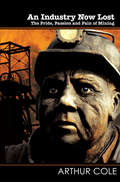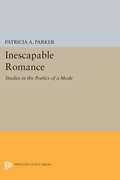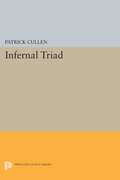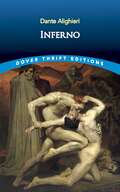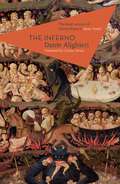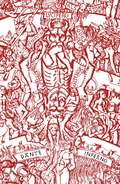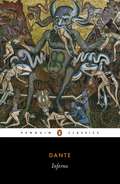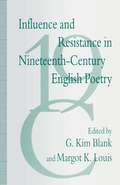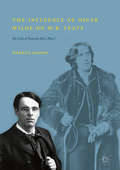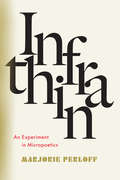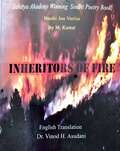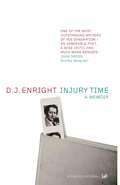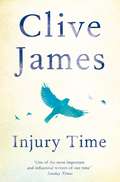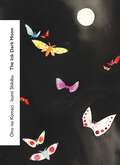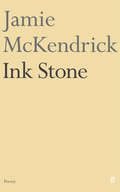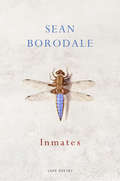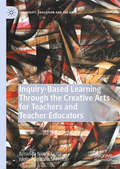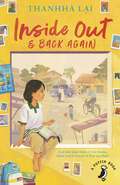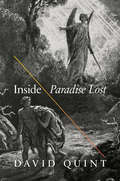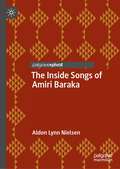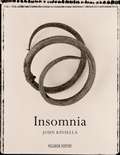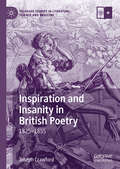- Table View
- List View
An Industry Now Lost: The Pride, Passion and Pain of Mining (Wordcatcher Modern Poetry)
by Arthur ColeAn ‘Industry Now Lost’ is a book of poems on the subject of coal mining throughout the UK and other countries of the world. It mostly portrays mining disasters from Victorian times, however there are more modern disasters depicted like 'Aberfan’ in 1966 and ‘Gleision’ in 2011. Arthur Cole is from a mining background and has seen the industry decimated in modern times. There are poems relating to the resolve of miners and their endeavour to succeed, one such poem, A tribute to tower, is about a colliery bought out by the work miners. For thirteen years they worked for themselves. The driving force behind this was their leader, Tyrone O’Sullivan. This was a great achievement at a time when collieries were closing left, right and centre. On a sadder note there is one on the closing of Kellingley Colliery, the last deep mine in the UK. There are many other noteworthy disasters commemorated ,such as Senghenydd, Gresford and Parc Slip. In these disasters many brave men and children lost their lives. Many of the poems relate to conditions during Victorian times, where whole families worked underground, even children as young as six years of age. To say conditions were grim is an understatement. Workers were treated with disdain and health and safety was non existent. In Victorian times it was all about profit, the rich got richer and the poor were discarded. There are poems relating to pit ponies and canaries outlining the vital role they played underground. There is a poem ‘The Keeper of the Collieries’ a nine-foot-high oak statue of a miner. The statue looks down on the Llynfi Valley, Maesteg. This valley that once boasted three working coal mines within two miles of each other, sadly no more. With the poems Arthur describes the dangers of mining over a long period of time and the bravery and resolve of those individuals who dare to work in the bowels of the earth.
Inescapable Romance: Studies in the Poetics of a Mode
by Patricia A. ParkerDefining "romance" as a form that simultaneously seeks and postpones a particular end, revelation, or object, Patricia Parker interprets its implications and transformations in the works of four major poets—Ariosto, Spenser, Milton, and Keats. In placing the texts within their literary and historical contexts, Professor Parker provides at once a literary history of romance as genre, a fresh reading of individual poems, and an exploration of the continuing romance of figurative language itself.Originally published in 1979.The Princeton Legacy Library uses the latest print-on-demand technology to again make available previously out-of-print books from the distinguished backlist of Princeton University Press. These editions preserve the original texts of these important books while presenting them in durable paperback and hardcover editions. The goal of the Princeton Legacy Library is to vastly increase access to the rich scholarly heritage found in the thousands of books published by Princeton University Press since its founding in 1905.
Infernal Triad: The Flesh, the World, and the Devil in Spenser and Milton
by Patrick CullenOne of the few theological formulas of medieval times to survive the scrutiny of the Reformation was that of the infernal triad of the sins of the Flesh, the World, and the Devil. Through a close analysis of the structural and thematic role that this triad plays in Books I and II of the Faerie Queene and in Paradise Lost, Paradise Regained, and Samson Agonistes, Patrick Cullen explores the imaginative continuity between two of the greatest poets of the English Renaissance, Edmund Spenser and John Milton. By presenting the two poets in a single focus. Professor Cullen demonstrates the profound indebtedness of Milton to Spenser, a relationship which has not received due scholarly attention, despite Milton's praise of Spenser as "a better teacher than Aquinas" and his admission according to Dryden, that Spenser was his "original." Professor Cullen's new approach allows him to define a clear allegorical lineage between some of the major poems of the period, demonstrating the imaginative affinity of Spenser and Milton with great concreteness and specificity.Originally published in 1975.The Princeton Legacy Library uses the latest print-on-demand technology to again make available previously out-of-print books from the distinguished backlist of Princeton University Press. These editions preserve the original texts of these important books while presenting them in durable paperback and hardcover editions. The goal of the Princeton Legacy Library is to vastly increase access to the rich scholarly heritage found in the thousands of books published by Princeton University Press since its founding in 1905.
Inferno
by Dante Alighieri Henry Wadsworth LongfellowEnter the unforgettable world of The Inferno and travel with a pair of poets through nightmare landscapes of eternal damnation to the very core of Hell. The first of the three major canticles in La divina commedia (The Divine Comedy), this fourteenth-century allegorical poem begins Dante's imaginary journey from Hell to Purgatory to Paradise. His encounters with historical and mythological creatures--each symbolic of a particular vice or crime--blend vivid and shocking imagery with graceful lyricism in one of the monumental works of world literature.This acclaimed translation was rendered by the beloved nineteenth-century poet, Henry Wadsworth Longfellow. A skilled linguist who taught modern languages at Harvard, Longfellow was among the first to make Dante’s visionary poem accessible to American readers.
The Inferno
by Ciaran Carson'Quite simply the best version of Dante there is' PAUL MULDOON, Irish Times. Almost eight centuries after its first publication, Dante Alighieri's Divine Comedy remains an icon of Italian literature and of the epic genre. In Inferno, the first volume, the poet Virgil leads Dante's hero through hell, showing him the inhabitants of each of its nine circles and examples of the divine justice meted out to them. In this beautifully produced Apollo Library edition, Ciaran Carson's translation suffuses the text with wit, anger and irreverent vigour, without diminishing the pathos of the original. This is a retelling of Dante's epic journey for the twenty-first-century reader.
Inferno: Poema - Primary Source Edition (Divine Comedy Ser. #1)
by Dante Robin KirkpatrickDiscover Dante's original Inferno in this modern and acclaimed Penguin translation. Describing Dante's descent into Hell with Virgil as a guide, Inferno depicts a cruel underworld in which desperate figures are condemned to eternal damnation for committing one or more of seven deadly sins. As he descends through nine concentric circles of increasingly agonising torture, Dante encounters many doomed souls before he is finally ready to meet the ultimate evil in the heart of Hell: Satan himself.This new edition of Inferno includes explanatory notes and an illustration of Dante's plan of hell. Robin Kirkpatrick's masterful translation is also available in a bilingual Penguin edition, with the original Italian on facing pages, and in a complete edition of The Divine Comedy with an introduction and other editorial materials. Dante Alighieri was born in 1265. He studied at the university of Bologna, married at the age of twenty and had four children. His first major work was La Vita Nuova (1292), a tribute to Beatrice Portinari, the great love of his life who had died two years earlier. In 1302, Dante's political activism resulted in his being exiled from Florence. After years of wandering, he settled in Ravenna and in about 1307 began writing The Divine Comedy. Dante died in 1321.Robin Kirkpatrick is a poet and widely-published Dante scholar. He has taught courses on Dante's Divine Comedy in Hong Kong, Dublin and Cambridge, where is Fellow of Robinson College and Professor of Italian and English Literatures.'The perfect balance of tightness and colloquialism...likely to be the best modern version of Dante' - Bernard O'Donoghue
Inferno: The Divine Comedy I (Divine Comedy Ser. #Vol. 1)
by Dante Robin KirkpatrickDescribing Dante's descent into Hell midway through his life with Virgil as a guide, Inferno depicts a cruel underworld in which desperate figures are condemned to eternal damnation for committing one or more of seven deadly sins. As he descends through nine concentric circles of increasingly agonising torture, Dante encounters doomed souls including the pagan Aeneas, the liar Odysseus, the suicide Cleopatra, and his own political enemies, damned for their deceit. Led by leering demons, the poet must ultimately journey with Virgil to the deepest level of all. For it is only by encountering Satan, in the heart of Hell, that he can truly understand the tragedy of sin.
Influence and Resistance in Nineteenth-Century English Poetry
by G. Kim Blank Margot K. LouisTo what extent is the distinction between 'Romantic' and 'Victorian' valuable or just? Is the Romantic/Victorian demarcation merely a convenience for the sake of the curriculum? How is the quarrel among different strains of Romanticism continued and developed in the Victorian period? How do Victorian texts interact with, echo, or resist Romantic texts? In what ways did the Romantic poets establish the terms within which, or against which, Victorian poets were debating? This volume of original essays addresses these questions; it also demonstrates how well the Romantics thought, and with what ferocious diligence the Victorians explored, resisted, and reworked the Romantic vision.
The Influence of Oscar Wilde on W.B. Yeats: "An Echo of Someone Else’s Music"
by Noreen DoodyThis book asserts that Oscar Wilde (1854 – 1900) was a major precursor of W.B. Yeats (1865 – 1939), and shows how Wilde’s image and intellect set in train a powerful influence within Yeats’s creative imagination that remained active throughout the poet’s life. The intellectual concepts, metaphysical speculations and artistic symbols and images which Yeats appropriated from Wilde changed the poet’s perspective and informed the imaginative system of beliefs that Yeats formulated as the basis of his dramatic and poetic work.Section One, 'Influence and Identity' (1888 – 1895), explores the personal relationship of these two writers, their nationality and historical context as factors in influence. Section Two, 'Mask and Image' (1888 – 1917), traces the creative process leading to Yeats’s construction of the antithetical mask, and his ideas on image, in relation to the role of Wilde as his precursor. Finally, 'Salomé: Symbolism, Dance and Theories of Being' (1891 – 1939) concentrates on the immense influence that Wilde’s symbolist play, Salomé, wrought on Yeats’s imaginative work and creative sensibility.
The Influence of Oscar Wilde on W.B. Yeats: "An Echo of Someone Else’s Music"
by Noreen DoodyThis book asserts that Oscar Wilde (1854 – 1900) was a major precursor of W.B. Yeats (1865 – 1939), and shows how Wilde’s image and intellect set in train a powerful influence within Yeats’s creative imagination that remained active throughout the poet’s life. The intellectual concepts, metaphysical speculations and artistic symbols and images which Yeats appropriated from Wilde changed the poet’s perspective and informed the imaginative system of beliefs that Yeats formulated as the basis of his dramatic and poetic work.Section One, 'Influence and Identity' (1888 – 1895), explores the personal relationship of these two writers, their nationality and historical context as factors in influence. Section Two, 'Mask and Image' (1888 – 1917), traces the creative process leading to Yeats’s construction of the antithetical mask, and his ideas on image, in relation to the role of Wilde as his precursor. Finally, 'Salomé: Symbolism, Dance and Theories of Being' (1891 – 1939) concentrates on the immense influence that Wilde’s symbolist play, Salomé, wrought on Yeats’s imaginative work and creative sensibility.
Infrathin: An Experiment in Micropoetics
by Marjorie PerloffEsteemed literary critic Marjorie Perloff reconsiders the nature of the poetic, examining its visual, grammatical, and sound components. The “infrathin” was Marcel Duchamp’s playful name for the most minute shade of difference: that between the report of a gunshot and the appearance of the bullet hole, or between two objects in a series made from the same mold. “Eat” is not the same thing as “ate.” The poetic, Marjorie Perloff suggests, can best be understood as the language of infrathin. For in poetry, whether in verse or prose, words and phrases that are seemingly unrelated in ordinary discourse are realigned by means of sound, visual layout, etymology, grammar, and construction so as to “make it new.” In her revisionist “micropoetics,” Perloff draws primarily on major modernist poets from Stein and Yeats to Beckett, suggesting that the usual emphasis on what this or that poem is “about,” does not do justice to its infrathin possibilities. From Goethe’s eight-line “Wanderer’s Night Song” to Eliot’s Four Quartets, to the minimalist lyric of Rae Armantrout, Infrathin is designed to challenge our current habits of reading and to answer the central question: what is it that makes poetry poetry?
Infrathin: An Experiment in Micropoetics
by Marjorie PerloffEsteemed literary critic Marjorie Perloff reconsiders the nature of the poetic, examining its visual, grammatical, and sound components. The “infrathin” was Marcel Duchamp’s playful name for the most minute shade of difference: that between the report of a gunshot and the appearance of the bullet hole, or between two objects in a series made from the same mold. “Eat” is not the same thing as “ate.” The poetic, Marjorie Perloff suggests, can best be understood as the language of infrathin. For in poetry, whether in verse or prose, words and phrases that are seemingly unrelated in ordinary discourse are realigned by means of sound, visual layout, etymology, grammar, and construction so as to “make it new.” In her revisionist “micropoetics,” Perloff draws primarily on major modernist poets from Stein and Yeats to Beckett, suggesting that the usual emphasis on what this or that poem is “about,” does not do justice to its infrathin possibilities. From Goethe’s eight-line “Wanderer’s Night Song” to Eliot’s Four Quartets, to the minimalist lyric of Rae Armantrout, Infrathin is designed to challenge our current habits of reading and to answer the central question: what is it that makes poetry poetry?
Inheritors Of Fire: Sahitya Akademy Winning Sindhi Poetry Book Baahi Jaa Varisa
by M. Kamal“Inheritors of Fire” is an anthology of Ghazals. This book received coveted Sahitya Akademi Award.
Injury Time: A Memoir
by D J EnrightThe distinguished poet, essayist and critic D. J. Enright died on the last day of December 2002. He had just put the finishing touches to Injury Time, a memoir and his third commonplace book in which the dying writer muses upon his own condition and that of the world he knows he is leaving. Comparing himself to the Chinese scholar Sima Qian, who chose an 'ignoble punishment' (in Dennis Enright's case, treatment for his cancer; in Qian's, castration) over respectable death in order to finish a book, he contemplates literature, manners, morals, people and, especially, the English language in all its glories and eccentricities - while recording his battle against cancer and his hospital experiences. Moving, and at times deeply poignant, imbued with its author's legendary humanity and wit, Injury Time is, nevertheless, funny, bracing and, above all, positive.
Injury Time
by Clive James'James's confrontation with his approaching death is nothing short of inspirational' Joan Bakewell, IndependentThe publication of Clive James's Sentenced to Life was a major literary event: critically acclaimed, it debuted at #2 in the Sunday Times bestseller list. Facing the end, James looked back over his life with a clear-eyed and unflinching honesty to produce his finest work: poems of extraordinary power that spoke to our most elemental emotions. Injury Time, following Sentenced to Life, finds James with more time on the clock than he had anticipated, and all the more determined to use it wisely – to capture the treasurable moment, and think about how best to live his remaining days while the sense of his own impending absence grows all the more powerfully acute. In a series of intimate poems – from childhood memories of his mother, to a vision of his granddaughter in graceful acrobatic flight – James declares ‘family’ to be our greatest blessing. He also writes beautifully of the Australia where he began his life, and where he hopes to 'reach the end'. Throughout Injury Time, James weaves poems which reflect on the consolation and wisdom to be found in the art, music and books which have become ever more precious to him in his last years.The poems in this moving, inspirational and unsentimental book are as accomplished as any he has ever written; indeed the unexpected gift of James's Injury Time shows him to be in the form of his life.
The Ink Dark Moon (Vintage Classics Love Poems)
by Izumi Shikibu Ono no KomachiHere is a collection of sexy, brief, fleeting poems about love, lust and longing. They originate from a time in Japanese history where aristocratic women of the Heian court were free to marry and conduct love affairs according to their desires. Education and refinement were so highly valued that the courtly manner of expressing oneself, whether to give condolences for a death, to send back a forgotten fan, or to heighten the anticipation of a lover's visit, was with a poem of just five lines. A convention of secrecy surrounding love affairs fills these verses with palpable emotion.These vivid and erotic poems express love in all its forms, and do so with amazing economy of words, unforgettable imagery and breath-taking modernity.INTRODUCED BY NIKITA GILL'They are full of dreams, of autumns, of lovers known or not yet met, of desire, wonderment, loneliness' Irish Times Translated by Jane Hirshfield with Mariko Aratani, this is an edition that brings the story of the poems to life with a detailed introduction and notes on the translation.
Ink Stone
by Jamie McKendrickThe best ink stones are slates from Chinese riverbeds, but in the long history of their use these have all been found. As one expert writes, 'the better the stone, the smaller and more consistent the particles will be and the denser the ink.' These new poems by Jamie McKendrick have a remarkable density of ink. They explore the grain, or 'tooth', of the natural world with unusual and discomforting detail at the same time as they chart the medium they work in - not only what the eye sees, but the eye itself: its structure and structurings. These poems open onto conflicting perspectives of home and abroad, the domestic and the wild, the natural and the uncanny, elegy and celebration.
Inmates
by Sean BorodaleThe poems of Inmates stage encounters with insects at sites and moments of their refuge, torpor, hatching or fighting, of traversing a floor in the night or climbing a wall, of their death and decay – all in and around the house of the writer, with whom they are sharing time, as fellow inmates. There is an urgency to these poems, emerging from the instant of their writing, and the close attention Borodale brings to his observation of the natural world results in poems of real intensity. Inmates is an attempt to co-exist with the natural world – examining it, intimately, at the edge of language itself, where the human voice begins to break apart.
Inquiry-Based Learning Through the Creative Arts for Teachers and Teacher Educators (Creativity, Education and the Arts)
by Amanda Nicole Gulla Molly Hamilton ShermanThis book is a theoretical and practical guide to implementing an inquiry-based approach to teaching which centers creative responses to works of art in curriculum. Guided by Maxine Greene’s philosophy of Aesthetic Education, the authors discuss the social justice implications of marginalized students having access to the arts and opportunities to find their voices through creative expression. They aim to demystify the process of inquiry-based learning through the arts for teachers and teacher educators by offering examples of lessons taught in high school classrooms and graduate level teaching methods courses. Examples of student writing and art work show how creative interactions with the arts can help learners of all ages deepen their skills as readers, writers, and thinkers.
Inside Out & Back Again
by Thanhhà LaiTen-year-old Hà has only ever known Saigon: the thrills of its markets, the joy of its traditions, and the warmth of her family and friends close by. But when the Vietnam War reaches the gates of her home, Hà and her family are forced to flee.The journey onboard a refugee ship bound for America is hard - but nothing can prepare Hà for the strangeness of the country that greets them on the other side. The language is impossible, the food is strange - and not all the locals are friendly. But amongst her struggles, Hà finds joy, friendship - and most of all, the power of hope, love and family.
Inside "Paradise Lost": Reading the Designs of Milton’s Epic
by David QuintInside "Paradise Lost" opens up new readings and ways of reading Milton's epic poem by mapping out the intricacies of its narrative and symbolic designs and by revealing and exploring the deeply allusive texture of its verse. David Quint’s comprehensive study demonstrates how systematic patterns of allusion and keywords give structure and coherence both to individual books of Paradise Lost and to the overarching relationship among its books and episodes. Looking at poems within the poem, Quint provides new interpretations as he takes readers through the major subjects of Paradise Lost—its relationship to epic tradition and the Bible, its cosmology and politics, and its dramas of human choice.Quint shows how Milton radically revises the epic tradition and the Genesis story itself by arguing that it is better to create than destroy, by telling the reader to make love, not war, and by appearing to ratify Adam’s decision to fall and die with his wife. The Milton of this Paradise Lost is a Christian humanist who believes in the power and freedom of human moral agency. As this indispensable guide and reference takes us inside the poetry of Milton’s masterpiece, Paradise Lost reveals itself in new formal configurations and unsuspected levels of meaning and design.
Inside "Paradise Lost": Reading the Designs of Milton’s Epic
by David QuintInside "Paradise Lost" opens up new readings and ways of reading Milton's epic poem by mapping out the intricacies of its narrative and symbolic designs and by revealing and exploring the deeply allusive texture of its verse. David Quint’s comprehensive study demonstrates how systematic patterns of allusion and keywords give structure and coherence both to individual books of Paradise Lost and to the overarching relationship among its books and episodes. Looking at poems within the poem, Quint provides new interpretations as he takes readers through the major subjects of Paradise Lost—its relationship to epic tradition and the Bible, its cosmology and politics, and its dramas of human choice.Quint shows how Milton radically revises the epic tradition and the Genesis story itself by arguing that it is better to create than destroy, by telling the reader to make love, not war, and by appearing to ratify Adam’s decision to fall and die with his wife. The Milton of this Paradise Lost is a Christian humanist who believes in the power and freedom of human moral agency. As this indispensable guide and reference takes us inside the poetry of Milton’s masterpiece, Paradise Lost reveals itself in new formal configurations and unsuspected levels of meaning and design.
The Inside Songs of Amiri Baraka (Palgrave Studies in Music and Literature)
by Aldon Lynn NielsenThe Inside Songs of Amiri Baraka examines the full length of Baraka’s discography as a poet recording with musicians as well as his contributions to jazz and R & B, beginning with his earliest studio recordings in 1965 and continuing to the last year of his life, 2014. This recorded history traces his evolution from the era of Beat poetry and “projective verse,” through the period of the Black Arts Movement and cultural nationalism, and on to his commitments to “third world Marxism,” which characterized the last decades of his life. The music enfolding Baraka’s recitations ranges from traditional African drumming, to doo wop, rhythm and blues, soul and the avant garde jazz that was his great love and the subject of so much of his writing, and includes both in-studio sessions and live concert performances. This body of work offers a rare opportunity to think about not only jazz/poetry, but the poet in the recording studio and the relations of text to score.
Insomnia
by John KinsellaThe Australian poet John Kinsella’s vivid and urgent new collection addresses the crisis of being that currently afflicts us: Kinsella addresses a situation where the creations of the human imagination, the very means by which we extend our empathies into the world – art, music and philosophy – suddenly find themselves in a world that not only denies their importance, but can sometimes seem to have no use for them at all. In an attempt to find a still point from which we might reconfigure our perspective and address the paradoxes of our contemporary experience, Kinsella has written poems of self-accusation and angry protest, meditations on the nature of loss and trauma, and full-throated celebrations of the natural world. Ranging from Jam Tree Gully, Western Australia to the coast of West Cork, Ireland, haunted by historical and literary figures from Dante to Emily Brontë (whom Kinsella has obsessed over since he was a child, and who intervenes in the poet’s attempts to come to grips with ideas of colonization and identity), Insomnia may be Kinsella’s most various and powerful collection to date.
Inspiration and Insanity in British Poetry: 1825–1855 (Palgrave Studies in Literature, Science and Medicine)
by Joseph CrawfordThis book explores the ways in which poetic inspiration came to be associated with madness in early nineteenth-century Britain. By examining the works of poets such as Barrett, Browning, Clare, Tennyson, Townshend, and the Spasmodics in relation to the burgeoning asylum system and shifting medical discourses of the period, it investigates the ways in which Britain’s post-Romantic poets understood their own poetic vocations within a cultural context that insistently linked poetic talent with illness and insanity. Joseph Crawford examines the popularity of mesmerism among the writers of the era, as an alternative system of medicine that provided a more sympathetic account of the nature of poetic genius, and investigates the persistent tension, found throughout the literary and medical writings of the period, between the Romantic ideal of the poet as a transcendent visionary genius and the ‘medico-psychological’ conception of poets as mere case studies in abnormal neurological development.
